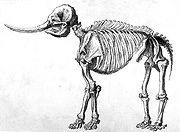
Mastodon State Historic Site
Encyclopedia
Mastodon State Historic Site is an archaeological
and paleontological
site in Imperial, Missouri
, containing the Kimmswick Bone Bed
. Bones of mastodon
s and other now-extinct animals were first found here in the early 19th century. The area gained fame as one of the most extensive Pleistocene
ice age deposits in the country and attracted scientific interest worldwide.
 Archaeological history was made at the site in 1979 when scientists excavated a stone spear point made by hunters of the Clovis culture
Archaeological history was made at the site in 1979 when scientists excavated a stone spear point made by hunters of the Clovis culture
(14,000 - 10,000 years ago) in direct association with mastodon bones. This was the first solid evidence of the coexistence of people and these giant prehistoric beasts.
Today, the 425 acres (1.7 km²) property preserves this National Register of Historic Places
site and provides recreational opportunities. A museum tells the natural and cultural story of the oldest American Indian site one can visit in the state's park system. A full-size replica of a mastodon skeleton highlights the exhibits. A picnic area, several trails and a special-use campground offer chances to explore the land where the lives of Native Americans and mastodons once intertwined.
38.379167°N 90.394722°W
Archaeology
Archaeology, or archeology , is the study of human society, primarily through the recovery and analysis of the material culture and environmental data that they have left behind, which includes artifacts, architecture, biofacts and cultural landscapes...
and paleontological
Paleontology
Paleontology "old, ancient", ὄν, ὀντ- "being, creature", and λόγος "speech, thought") is the study of prehistoric life. It includes the study of fossils to determine organisms' evolution and interactions with each other and their environments...
site in Imperial, Missouri
Imperial, Missouri
Imperial is a census-designated place in Jefferson County, Missouri, United States. The estimated population in 2007 was 4,747. It was 4,373 at the 2000 census. It was originally known as West Kimmswick, and is roughly 25 driving minutes south of St. Louis. St...
, containing the Kimmswick Bone Bed
Bone bed
A bone bed is any geological stratum or deposit that contains bones of whatever kind. Inevitably, such deposits are sedimentary in nature. Not a formal term, it tends to be used more to describe especially dense collections...
. Bones of mastodon
Mastodon
Mastodons were large tusked mammal species of the extinct genus Mammut which inhabited Asia, Africa, Europe, North America and Central America from the Oligocene through Pleistocene, 33.9 mya to 11,000 years ago. The American mastodon is the most recent and best known species of the group...
s and other now-extinct animals were first found here in the early 19th century. The area gained fame as one of the most extensive Pleistocene
Pleistocene
The Pleistocene is the epoch from 2,588,000 to 11,700 years BP that spans the world's recent period of repeated glaciations. The name pleistocene is derived from the Greek and ....
ice age deposits in the country and attracted scientific interest worldwide.

Clovis culture
The Clovis culture is a prehistoric Paleo-Indian culture that first appears 11,500 RCYBP , at the end of the last glacial period, characterized by the manufacture of "Clovis points" and distinctive bone and ivory tools...
(14,000 - 10,000 years ago) in direct association with mastodon bones. This was the first solid evidence of the coexistence of people and these giant prehistoric beasts.
Today, the 425 acres (1.7 km²) property preserves this National Register of Historic Places
National Register of Historic Places
The National Register of Historic Places is the United States government's official list of districts, sites, buildings, structures, and objects deemed worthy of preservation...
site and provides recreational opportunities. A museum tells the natural and cultural story of the oldest American Indian site one can visit in the state's park system. A full-size replica of a mastodon skeleton highlights the exhibits. A picnic area, several trails and a special-use campground offer chances to explore the land where the lives of Native Americans and mastodons once intertwined.
External links
38.379167°N 90.394722°W

